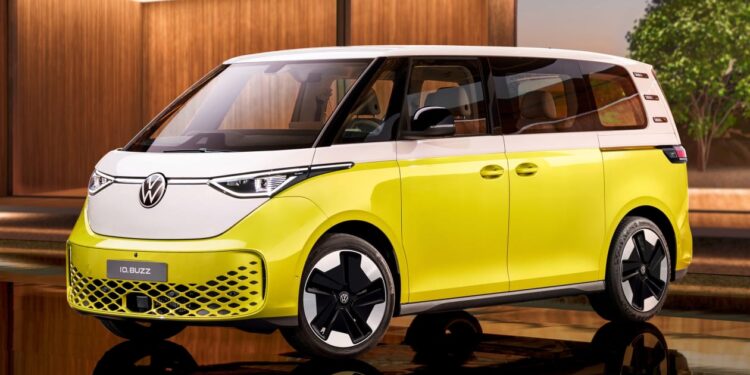The all-electric MPV sector is growing rapidly with the likes of the Mercedes EQV sitting at the premium end of the market and the Citroen e-Berlingo propping up the more budget-conscious side. Sitting somewhere in the middle is this: the new ID. Buzz.
The Volkswagen ID. Buzz is currently available in two trim levels. The top spec 1st Edition has gone off sale, so it’s now a choice between the £57,115 Life and the £61,915 Style. Both versions come with the same battery pack and 258-mile range.
The German firm has also previously revealed it is planning on bringing its sporty GTX moniker to every one of its all-electric ID cars – including the new ID.Buzz, which will line-up as a unique proposition: a hot, all-electric minibus.
The GTX will sit at the top of the range, so it should receive at least the same level of equipment found in the Style. What it should gain over the standard ID. Buzz is the powertrain from the ID.5 GTX – the same 77kWh battery but pumping out 295bhp and 310Nm of torque to a dual-motor, four-wheel-drive set-up.
Elsewhere, the exterior will probably feature a few small nods to the added sportiness and the interior should have some red touches – as seen on previous GTX models.
The standard £57,115 entry-level Life model offers LED headlights, heated windscreen, VW’s Buzz Box removable storage, the firm’s Discover Pro sat-nav set-up as part of a 10-inch infotainment system, and wireless charging. There are also 19-inch wheels, a heated multifunction steering wheel and Android Auto and Apple CarPlay compatibility.
The Style model adds 20-inch wheels, IQ. Light LED matrix headlights, adaptive interior ambient lighting and a powered tailgate.
An all-wheel drive version of the ID. Buzz is coming without the GTX power. The ID.4 GTX and ID.5 GTX utilise two electric motors (one on each axle) to provide four-wheel drive, so we expect the same in the ID.Buzz AWD. Just like the ID.4 and ID.5 GTX models, range will likely decrease with the battery powering two motors.
For now, every model in the ID.Buzz range features the same running gear as the ID.3. That means a 77kWh battery, sending 201bhp and 310Nm of torque to the rear wheels. Volkswagen claims the ID.Buzz is capable of an all-electric range of up to 258 miles.
There’s 170kW charging on board, so the battery can be topped up from five to 80 per cent capacity in 30 minutes from a powerful-enough DC source. What’s more, the ID.Buzz features bi-directional charging, so not only will owners be able to charge the car at home, they’ll also be able to feed energy from the battery back into the grid.
The production version of the ID.Buzz remains largely unchanged from the concepts that we’ve seen since 2017. It’s a fairly standard one-box minivan shape with a rakish windscreen, while VW claims a drag coefficient of 0.29Cd to help boost efficiency.
Slender LED headlights feature up front with a light bar stretching between them to connect with the large VW badge in the middle, while further down is a mesh grille design for the lower air intakes. Sliding side doors feature, while the rearmost pillars use a three-bar design motif.
There is a full-height tailgate with slender lights across the full width of the rear end. The two-tone colour scheme seen in the first official pictures will be offered as an option, with yellow, orange, blue or green bodywork beneath a white upper section.
Overall the ID. Buzz is relatively compact. At 4,712mm long, it’s 192mm shorter than the T6 Caravelle, but has a wheelbase of 2,988mm, which is almost identical to the T6. This helps to maximise passenger space, but while the concepts featured clever sliding and rotating seats, the ID. Buzz has a conventional five-seat layout in a 2-3 configuration. The rear bench splits 60:40 and slides to maximise legroom or cargo space, though, and there’s a vast 1,121 litres of boot space in five-seat mode. Fold the rear bench flat, and a maximum of 2,205 litres is on offer.
A seven-seat model was teased in an investor presentation in October, showing how it looks on the inside with a third row made up of two seats. A long-wheel base version was also alluded to although we’re yet to see inside the more capacious model.
Go for a two-tone exterior, and the cabin will have the same colour theme, although we’ll have to wait and see how easy it will be to keep the white steering wheel and upholstery looking good. Practical touches include up to eight USB-C charging sockets throughout the cabin, while a new innovation is the ‘Buzz Box’. This is a central storage bin that sits between the front seats and contains a top compartment housing an ice scraper and bottle opener, bottle storage and a large five-litre drawer for stowing bulkier items.
Another innovation is the elimination of leather upholstery in the cabin. The steering wheel is wrapped in a synthetic alternative, while the carpets and seat fabrics all come with varying levels of recycled plastic within them. It’s part of VW’s aim to make the ID. Buzz carbon neutral all the way from manufacture to delivery.
There’s plenty of technology on board the ID. Buzz, and most of it is carried over from the ID.3 and ID.4. There’s a 5.4-inch Virtual Cockpit driver’s display, while a 10-inch touchscreen infotainment system features on the Life model, the higher-spec models get a 12-inch screen mounted centrally on the dashboard. As with other ID models, touch-sensitive climate controls feature, while wireless Apple CarPlay and Android Auto, online connectivity and voice control are all included.
Volkswagen ID. Buzz ‘Notarzt’ revealed in Hannover
At the IAA Transportation show in Hannover, Volkswagen unveiled a special conversion for the ID. Buzz. German superstructure manufacturer Bösenberg had modified the ID. Buzz for use by Germany’s Notarzt (paradmedics), highlighting the all-electric MPV’s capability of providing emergency services. It’s not known if there are plans for the ID. Buzz to be customised for other emergency services.
Click here for our list of the best electric cars on sale right now…


